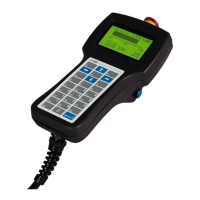Tech-note
tn202-2.doc - 10.01.2012
ePALM10 Product Manual
20
9 Reserved
10 Reserved
1 Enabling switch A (NO contact) 1 +24 VDC
2 Enabling switch A (NO contact) 2 Common
3 Enabling switch B (NO contact) 3 Reserved
4 Enabling switch B (NO contact) 4 PE
The Emergency Stop button is hardwired directly to the cable: the corresponding signals do not
appear listed in the connectors.
Note: the connection of the Emergency Stop button is intended only for connection to low voltage
circuits (below 48 VDC).
The wires in the cable are color-coded according to the table below.
Power
+24 VDC Red 0.75 21
Common Black 0.75 21
Aux Port (Profibus)
A Green 0.5 24
B Red 0.5 24
Additional Signals
Enabling switch A Blue-Black 0.75 21
Enabling switch A Blue 0.75 21
Enabling switch B Cyan-Black 0.75 21
Enabling switch B Cyan 0.75 21
Emergency Stop
Emergency Stop 1 Green 1 17
Emergency Stop 1 Yellow 1 17
Emergency Stop 2 Brown 1 17
Emergency Stop 2 Orange 1 17
The internal layout of the communication cable is shown in the figure below. Please note that the
ferrite toroid is required for proper operation and should not be removed.

